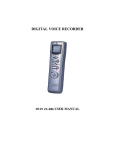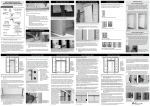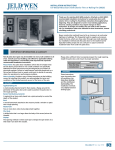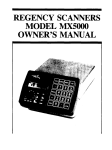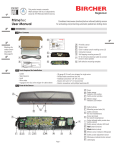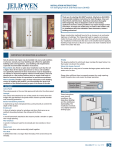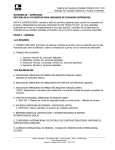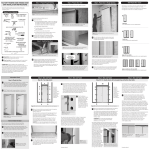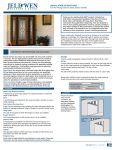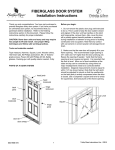Download none SH-904-UNF-30in Instructions / Assembly
Transcript
Special Order Program 1 of 16 MAIN DOOR CORPORATION LIMITED WARRANTY Main Door Corporation warrants, subject to the conditions and restrictions below, that its products are free from defects in material and workmanship for the period of one year beginning on the date of purchase by the customer. Should a Main Door Corporation product fail to conform to this written warranty, Main Door Corporation will, at its option, either: 1. 2. 3. 4. Repair the product found to be defective free of charge, or: Provide a replacement part or parts to repair the product found to be defective free of charge, or: Provide a replacement product in the same condition of fitting and finishing as the product that has been ordered originally, or: Refund the original price received for the product. Main Door Corporation shall not be responsible for any labor costs or other costs to remove defective products or to retrofit new products or parts. Main Door Corporation will not be held liable for any product repaired or replaced without its prior written consent. Main Door Corporation shall not be responsible for finishing costs of new products, unless purchased factory finished from Main Door Corporation and with its prior written consent to pay for those costs. THE FOLLOWING SHALL NOT BE CONSIDERED DEFECTS IN MATERIAL OR WORKMANSHIP AND ARE NOT COVERED BY THIS WARRANTY: 1. 2. 3. Warp for any door wider than 42" or taller than 96"; Warp for any nominal 1-3/4" thick by 42" wide by 96" high or smaller door, not exceeding 1/4" in the plane of the door itself; Bow or nonalignment in the frame or jamb in which the door is hung if such is purchased from 2 of 16 4. 5. 6. 7. 8. Main Door Corporation not machined and not prehung; Variations or unsatisfactory results in gloss level, texture or appearance resulting from the field application of paint or any other finishing material; Our products are primarily manufactured with wood. Wood, by its nature, has natural variations in color. These variations are considered enhancements and are not defects. All pieces of wood are unique. Some pieces of wood have more pronounced grain patterns than others. When pre-finished, the differences may be more pronounced and are not defects in the wood or finish. Additionally, bleed-through of wood pitch may be experienced – this is not considered a defect. Damage caused by others or by any cause beyond the control of Main Door Corporation, including, but not limited to: damage caused by misuse, abuse, accident, mishandling or by fire, flood, earthquake, storm, tornado or other acts of nature. "Misuse" of a door includes, but is not limited to, using a door on part of a building without providing adequate overhang or an appropriate finish color. Adequate overhang depends on the typical weather conditions of the area where the door is to be used, but typically means an overhang projecting a distance from the structure one half the elevation difference between the bottom of the door and the base of the overhang structure at the point which is farthest from the door. In order to reduce the chance of warping or checking, dark colored finishes should be avoided on all surfaces, especially on light colored wood species, or if the door is exposed to direct sunlight; Damage due to trimming more than ½’’ from the top or 1 ½’’ from the bottom and cutting into dowels; Failure to perform normal homeowner' s maintenance, including maintaining the finish (factory finish or non-factory finish); 3 of 16 9. 10. 11. 12. 13. 14. Product failure due to improper or incorrect installation; Attempts to repair Main Door Corporation products other than by Main Door Corporation representatives; Panel movement (shrinkage) of 1/4" or less. Wood doors are susceptible to expansion and contraction caused by temperature and humidity variations. These may cause the wood panels, that have been designed to "float", to shrink, leaving an unstained line along the panel edge and tiny cracks at the joints. These deviations from perfection are not considered flaws. While Main Door Corporation doors are a low-maintenance product, field touch-up may be required due to environmental conditions, dings, dents and the normal expansion and contraction of wood. Main Door Corporation takes extra measures to ensure that joint separation is minimal. However, it is normal to experience some joint separation in areas where stiles and rails meet and at casing joints. These are not considered defects. If joint separation occurs, the separated area must be sealed. Stains and fillers are available in all standard colors from Main Door Corporation. Damage caused by extreme temperature buildup where a storm door is utilized. Storm doors must be vented to eliminate this temperature buildup; Slight expansion or contraction due to varying environmental conditions, such as temperature and humidity; Doors shipped out of the continental Untied States or Hawaii are not warranted. This Warranty applies only if the Main Door Corporation product is installed in a structure located within the United States of America. Main Door Corporation does not warrant any product, which is installed outside the United States or Hawaii. This Warranty applies only to products as originally installed in the customer’s building and does not apply to any tear outs and reinstallations. 4 of 16 The exterior finish is warranted for a period of one (1) year from the date of purchase against cracking, peeling, checking or delaminating subject to the following terms and exclusions: Defects not covered under this Warranty include, but are not limited to: failures related to knots, finger-joints, stile and rail separation, cracking or failure of the substrate, improper installation and maintenance, moisture penetration, or improper cleaning. Should the finish fail, and the conditions set forth herein have been satisfied, Main Door Corporation will provide the full cost of replacement finishing during the first year of this Warranty. In the event that a failure occurs, Main Door Corporation, reserves the right to determine the best method needed to correct the situation, including, but not limited to, the refinishing in the field of the failed part(s). In order for the Warranty to be in effect, Main Door Corporation must be notified in writing of the failure within thirty (30) days of the discovery of such problem and provide documentation. Main Door Corporation may require clear pictures of the affected product. If Main Door Corporation chooses to repaint, we will use normal repainting practices including a trade paint product or other suitable alternatives. The Warranty also applies to any part we repaint/refinish, repair, or replace, but only for the unexpired portion of the Warranty period applicable to the original part. 5 of 16 Solid wood entry door Installation Instructions Materials for Installation: Touch-up stain / paint wax crayon [included w/ finished units only] Shims [not included] Caulking [not included] Sandpaper Grid 150 [not included] Casing or finish nails or # 8 X 3” and 2-1/4” drywall screws [not included] Lockset [not included] Primer or sanding sealer in case of unfinished units. [not included] Tools for Installation [not included]: Tape measure Level Hammer Caulking gun Square Screwdriver Power drill Miter saw For safety reasons it is recommended to use safety glasses and safety gloves when working with power tools. To install any prehung door unit larger than a single door unit, two people are required. Before starting the installation of any door unit, read Installation instructions carefully and check all necessary parts and tools needed [for list of tools and parts needed see above]. Note: these Instructions do not claim to be complete and different methods of door installation might be possible. Getting started: 1. 2. Check the rough opening of door. For the majority of installations, the distance between the left and right stud and the distance between the header and the floor should be about ½” to 1” wider and taller than the door unit’s overall width and height. All Main Door Units come when purchased as Prehung with ether a 1-3/16” height Aluminum 6 of 16 3. 4. 5. 6. 7. 8. 9. Oak Adjustable or a 1-1/4” Solid oak sill. Both provide adequate clearance for most floors, such as carpet, wood and tile. In case you need an even height clearance, the rough opening must be adjusted. Prior to installation check the rough opening to ensure that: The opening provides enough space a properly shimmed. The opening is not twisted. Minor twist can be corrected with shims. If the opening is badly twisted [not plum], you will have to fix the condition before proceeding. Prehung door units are shipped out by Main Door Corporation standing upright on a pallet, covered with white cardboard. Prior to installation, make sure that the unit is delivered in good condition. For installation, take the door (s) off the hinges by removing the hinge pins. Once the doors are removed, take the unit off the pallet and remove all package parts from the frame. Prepare threshold area of the door unit by putting two generous lines of caulking about ½” in distance to each other along the outer edge of the floor. It is important to make sure that the caulking beads will seal the floor and the threshold against moisture entering from the outside. Proceed with installation by carefully tilting the door into the door opening. Make sure that the previously applied caulking has contact with the threshold and that the hinge jamb leg is level. Replace one screw from the top and bottom hinge plate by a # 8 x 3” screw to temporarily fasten the jamb loosely into the stud. Or, remove the hinge plate and place screw behind the hinge plate to temporarily fasten the jamb loosely into the stud. Once the jamb is only fastened loosely, you can now begin to shim the hinge jamb from the inside behind the hinge location. Be sure that the hinge jamb leg is level in both directions and the entryway opening is square. Once the hinge jamb leg is fixed in a level and square position, start leveling and shimming the 7 of 16 10. 11. 12. 13. latch jamb leg in a square position. It is recommended to place a minimum of three shims between the stud and the jamb leg. Remove the Q-lon Weather stripping and temperately fasten the jamb about 2” from the top and from the bottom in an area that once the Q-lon is reinstalled will be covered with # 8 X 3” Drywall Screws. When installing a single door, do not shim and fasten the top of the unit. If you are installing a prehung unit that has sidelites, shim and fasten the top of the unit where the sidelite joins the doorjamb. After rechecking that the hinge jamb is still level and square, secure the jamb leg in place. Make sure that the door opens freely and the space between the door and the jamb is level on all sides. Be sure that the Q-lon meets and seals the door on all sides evenly, so when closed no light comes through. Adjust if necessary. In case of adjustments, loosen or remove the latch jamb fasteners and adjust the latch jamb until there is even contact with the weather stripping. Reassure that the door shoe touches the threshold evenly. Most doors have an oak adjustable aluminum threshold; in this case, you can make corrections by adjusting the adjustment screws on the top of the oak strip. These allow you an adjustment of maximum ¼”; in addition to the adjustment at the threshold, you can lower the door sweep by 1/8” by loosening its screws and pulling the door sweep down. If you have ordered the unit with a solid oak sill, you can adjust the threshold contact by adjusting the squareness of the door unit and lowering the door shoe. Recheck for smooth operation and even spacing between the door and the jamb. Secure the latch and the hinge jamb in place If you have a double door. some additional fastening is required. Double doors should be secured through the jamb head and into the door header with two 10D finish nails or two # 8 x 3” drywall screws. DO NOT SHIM THE TOP OF THE JAMB HEAD! 8 of 16 Below are some of the most common problems faced when installing DOUBLE DOORS Troubleshooting tips for installing double door and all Prehung units when installing prehung units particularly double door units; there are certain problems that may arise. Generally, the larger the opening, the more likely it is to be out of square. When installing units into an existing opening, it may not be sufficient enough to align the jambs with the existing framing. If the existing framing is out of square and the prehung unit is aligned with the existing framing, then the prehung unit will also be out of square. Problems with alignment can happen with any prehung unit but the problems are enhanced with double door units due to the extra door. Here are some solutions to the common problems of installing double door units. These solutions can also be used with other prehung units. Problem No. 1: Doors don’t align at top Prehung Unit out of square (exaggerated to show the problem) Doors aligned at top and bottom SOLUTIONS Shim at Points A, B and, or C. If there is sufficient spacing on the opposite sides of point A and B then shim at points A and B to shift frame and align doors at top and bottom. If there isn’t, shim at point C to lift up side and align doors 9 of 16 Problem No. 2: Doors don’t close together evenly. SOLUTION: Frame has to be shifted at point A, B, C and/ or D. Shift point A forward or right. Shift point B backward or left. Shift point C backward or left. Shift point D forward or right. Use any of these combinations in order to align doors. If doors are only slightly out of alignment the ½” hole for flush bolt can be drilled either forward or backward of center slightly. 10 of 16 Problem No. 3 Step from jamb to framing Step from jamb to Step from jamb to framing on the inside. The casing has to be back cut. framing on the outside. The brick mould has to be back cut. SOLUTIONS: If jambs are shifted to the point that there is a step from jamb to framing, then the casing or the brick mould will have to be back cut in order to install the moulding correctly (see examples). 11 of 16 Provided Brickmould and Casing Backcut Brickmould and Casing 14. Touch up any nail holes by rubbing the delivered (factory finished units only) crayon into the nail holes and rub off excess with a clean rack. For unfinished units, use wood putty to touch up nail holes. 15. Caulk around the outside of the door unit between the siding and the brick mould, along the front side of the threshold and between the jamb sides and the threshold. FAILURE TO FOLLOW PROPER INSTALLATION AND FINISHING INSTRUCTIONS WILL VOID THE WARRANTY! FINISHING INSTRUCTIONS: Before getting started, here are some helpful hints: Wear safety glasses for eye protection, and rubber gloves to avoid skin irritation. Always follow paint or stain manufacturers’ instructions. Ask your local hardware / paint store for the best quality materials and make sure that all materials are compatible with each other. Never finish only one side of the door. Always allow material used enough time to dry Seal and finish all six sides of a door. Remove hardware from door and mask off glass prior to finishing. Finish in a dust free, well-ventilated environment, away from the sunlight. STAIN- Finishing instructions When working with finishing materials, always follow the instructions of the material’s manufacturer. Always keep finishing materials out of reach of children. 1. 2. 3. 4. Lightly block sand the surfaces of the unit with sandpaper 150 grit in the direction of the wood grain. Never sand cross grain! Clean unit from all dust. Check all surfaces to be clean and smooth. Apply stain with a brush or cheesecloth evenly in direction of the grain. Wipe off excess stain to achieve the desired color and grain effect. After 12 of 16 5. the door is stained allow material to dry. Follow instructions of the stain manufacturer. Apply a minimum of two coats of clear Polyurethane or Varathane. Spray applications will achieve the best results. Make sure the door is sealed on all SIX sides. Follow the same procedure to stain other parts of the unit, e.g., jamb sets or moldings. FAILURE TO FOLLOW PROPER FINISHING INSTRUCTIONS AND ADEQUATE PROTECTION FROM WEATHER WILL VOID THE WARRANTY! PAINT- Finishing instructions 1. 2. 3. 4. 5. Lightly block sand the surfaces of the unit with sandpaper 150 grit in the direction of the wood grain. Never sand cross grain! Clean unit from all dust. Seal door with quality primer on all six sides. Allow primer to dry thoroughly(check instructions of manufacturer) Sand lightly with Sandpaper 320 grit and clean off dust. Apply second coat of primer. Make sure to use compatible materials. After drying, sand with sandpaper 320 grit, clean off dust and apply one even coat of to paint. FAILURE TO FOLLOW PROPER FINISHING INSTRUCTIONS AND ADEQUATE PROTECTION FROM WEATHER WILL VOID THE WARRENTY! 13 of 16 Maintenance and frequent asked questions Exposure Exposure to the elements, such as sun, wind, rain and any type of moisture will affect any well-finished exterior wood product. In order to preserve the beauty of your door and its protective finish, it is recommended to read the following: It is recommended to inspect the door at least once a year, and refinish if necessary. It is considered normal maintenance to refinish the topcoat approximately once a year. To maintain the topcoat it will not be necessary to strip the door! To refinish, the unit must be cleaned off all dust and residue given a light sanding the direction of the grain with 220-grit sandpaper. After sanding, wipe off all dust in the sanded areas. Thoroughly read and follow all instructions provided by the topcoat manufacturer on the can and apply accordingly. Depending on the environment in which the door is installed, refinishing might be required every 1 to 3 years. How should the door be cleaned? The first step in maintaining the finish of the door should be keeping it clean from dust, as dust holds and absorbs moisture on humid days. But not only does dust trap moisture, it also holds a high concentration of smog and pollution, which can act together with the moisture, like an acid, affecting the finish if not removed on a regular basis. Therefore, use a dust cloth, just like the one you use to clean furniture. After dusting the door, we do not recommend using any furniture polish, as those might affect the finish. Never use solvents, abrasive cleaners, detergents or soaps for cleaning; these might destroy the finish of your door. Do not wash the door with water or rinse it off with a hose, as this might lead to swelling of the door. We do not recommend the use of heavy waxes as they leave a residue. 14 of 16 Will it be necessary to reseal the wood after trimming sanding or planing? Your door whether finished or unfinished will require an additional sealing on any side that has been cut, sanded or planed. By cutting, sanding or planing finished door units during the process of the installation, you break the seal that has been applied by the factory. This seal needs to be reapplied to the door to give it the protection against moisture reentering or, in a dry environment, evaporation out of the pores of wood. For products purchased unfinished, you will have to seal the whole unit. Never expose unsealed, raw wood to the environment. An example of the effects of moisture on wood: • A 12” wide oak board that changes from 8% moister content to 4% moister content will shrink up to 3/16”! [12” 0.00369*4% 0.17712”+11/64” based on the Wood Engineering Handbook by the U.S. Forest Products Laboratory] Even though the shrinkage of species other than oak is different, the basics are the same. This is why it is very important to seal the pores of the wood carefully prior to installation and it is always a good idea to check the top and bottom edge of your door for proper sealing. How to touch up nicks and scratches. As time goes by, your door might get minor nicks and scratches. That is why Main Door Corporation provides every customer who purchased a finished unit with a touch up kit. This kit contains some stain and a touch up pen. If you have applied a finish other than the factory finish, we recommend that you keep on hand a small quantity of stain and sealer to repair small nicks and scratches. After applying the stain, allow the area to dry for approximately 2-4 hours. After the stain is dry, use an artist’s brush to apply a first coat of varnish. We recommend using an oil-based Polyurethane varnish in semi gloss for stained units. After applying the first coat, let the area dry for at least 1 to 2 hours before 15 of 16 an intermediate light sanding (use sandpaper P 320) and the application of the second coat. What happened if there is an unstained line around the panel showing? This line is caused by the contraction of the wood panel. As wood is a hygroscopic, natural product it reacts to changes of its environment and the changing conditions of the climate. The doors therefore are constructed with free-floating wood panels to minimize cracking of the wood. If the panels would be nailed or glued in place, the power of the contracting (or expanding in humid climates) panel would cause severe cracks and damages to the door. As a matter of fact, the power of the expansion of wood is so strong that it was used in ancient Egypt to break stones for the construction of the pyramids. As there was no dynamite available, Egyptian miners drove dry wood into a rock, added water and waited until the expanding wood cracked the rock. Lines around the panel can be touched up very easy. First, clean the area of all built ups and easy to remove varnish. Once this is done, stain the unstained raw wood. Use a fine brush to apply the stain. After the application of the stain wipe off the excess and let the stain dry slowly for 2-4 hours. After the stain is dry, use an artist’s brush to apply a first coat of varnish. We recommend using an oil-based Polyurethane varnish in semi gloss for stained units. After applying the first coat, let the area dry for at least 1 to 2 hours before an intermediate light sanding (use Sandpaper P 320) and the application of the second coat. 16 of 16
















